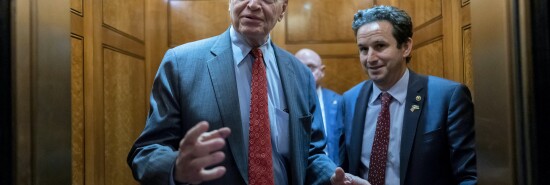
Omnibus spending bill split shows Republicans falling into familiar spending trap
W. James Antle III
Video Embed
The new Republican House majority hasn’t even been sworn in yet, and GOP lawmakers are already pointing fingers at each other on spending.
Spending has traditionally been something Republicans at the federal level want to cut when there is a Democratic president but are content to let balloon out of control once the White House has been painted red.
The $1.7 trillion omnibus spending bill has conservatives wondering if national Republicans are willing to even wait that long to break the bank.
ELON MUSK’S IMPERFECT EXPERIMENT WITH THE NEWEST WAVE OF LIBERAL-DOMINATED MEDIA
Of course, Republicans are no strangers to this dilemma either. You cannot balance the federal budget, reform entitlements, or restrain spending with control of the House alone, even if that is the chamber where appropriations and revenue bills originate.
To win spending cuts from a Democratic president and Senate, House Republicans likely must force a government shutdown at Christmas, for which they will be blamed. Republicans have been hurt politically by most partial government shutdowns since their first House majority in 40 years in 1995, with the significant exception of an immigration showdown in 2018 when a number of red-state Democrats were up for reelection in the Senate.
The alternative is to more or less go along with the status quo on spending, as House conservatives allege 18 Republican senators did with the latest government funding deal.
But the problem is hardly confined to the most recent fiscal fisticuffs. Republicans run against reckless Democratic spending and then either are perceived to be acquiescing to it or engaging in even riskier economic behavior to impose their will on whatever liberal sits behind the Resolute Desk.
This pattern has played out under Presidents Bill Clinton, Barack Obama, and now Joe Biden. In the first two cases, it resulted in the reelection of two Democratic chief executives who looked doomed just two years earlier.
Shut-it-all-down or go-along-to-get-along is hardly a choice at all. It gives Republicans the option of fiscal irresponsibility or making fiscal responsibility itself look irresponsible. And now it speaks to a larger temperamental divide within the party about its approach to governing more broadly.
Biden spent the weeks leading up to the midterm elections claiming Republicans would try to force him into cutting Social Security and Medicare by defaulting on the national debt. It’s not the only, or perhaps even the most important, reason Republicans then underperformed expectations. There’s nevertheless a reason this has been a standard part of the Democratic playbook for decades.
Fiscal brinkmanship has achieved some limited successes for limited government in the past. Federal spending surely ended up lower under the Clinton administration than if Democrats had kept control of Congress beyond the first two years. Some cuts were wrung out of Obama, whose inclination on fiscal policy was to the left of Clinton’s, through budget sequestration.
A new Republican majority will put the brake on Biden’s spending ambitions, and thus his ability to reignite inflation, simply by existing. Two of the biggest spending bills of the Biden administration were passed through reconciliation, which will now be virtually off the table. The GOP can stop other expenditures in their tracks no matter what legislative process is utilized, as long as the party’s members can stay together.
The general trajectory of federal spending and debt remained largely unchanged, however, and the political costs were significant. Republicans offered little resistance to the grand old spending party under Presidents George W. Bush and Donald Trump.
It may also be the case that some of the New Right conservatives are less motivated by spending and fiscal concerns more generally than they were in the heady days of Newt Gingrich and the 1994 “Republican revolution.” If so, the least compromise-inclined members of the GOP conference will have other priorities.
The omnibus spending bill is nevertheless likely to take its place in the pantheon of issues that separate conservative activists from establishment Republicans alongside the 1990 George H.W. Bush tax increase, the George W. Bush-era immigration amnesty proposals, and the 2008 Wall Street bank bailout.
CLICK HERE TO READ MORE IN THE WASHINGTON EXAMINER
That doesn’t obviate the need for a new strategy. The Penn Wharton Budget Model estimates the national debt, which hit $31 trillion this fall, is on track to exceed 225% of America’s gross domestic product by 2050.
But to most lawmakers who aren’t thinking past 2024, that’s a fiscal eternity.
